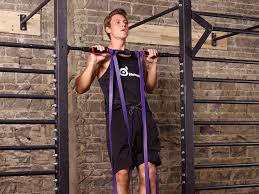2021-06-15
Whether you're a beginner in pull-ups or an athlete who wants to improve, resistance bands are a great tool to help you. So how do you pull up with resistance band? How to hang a resistance band for pull ups?You can read below.
This may not be the most important step, but it is always the first step. To do a pull-up correctly with a drag band, you first need a long drag band. You need a resistance band that stretches longer than your weight, or you may miss the point of your workout.
The resistance band you choose should match your body weight. You may need to experiment for yourself. You need a resistance band that will not provide enough strength for you. You must choose a band that provides the right amount of resistance to your wait and skill level. In general, orange has the least resistance, red has moderate resistance, and blue and green provide the most resistance. If you're new, start with blue or green.
1. Continuous band
Pull the strap loop over the top of the rod, and then pull the other end of the strap loop through the loop you pulled over the top. Pull that loop over so there's a lacing loop at the top of the rod and an opening for the foot at the bottom.
2. Single tie
Tie lace to the rods at each end of the resistance band and tie each to a safety knot. Test it by pulling the hand ring to make sure it is safe. Some knots come into play here, including making a loop first and then using the above technique as if you already have a continuous loop.
Bring the middle of the strong foot into the bottom of the strap. Bend the non-working leg slightly and cross it behind the dominant leg. Hold the pull-up bar with your hands slightly wider than the width of your arms. If you can't get through the pole, balance on a chair or gym box. Slide your back down with your shoulder blades and work your abdominal muscles.
Your hips and pelvis should be supported at all times to keep your body stable during the exercise. As your elbows bend and point toward the concrete, lift your head up and try to get your chin closer to the bar.
Slowly let your body fall, straighten your arms, and return to the starting point. Then continue with the repeated exercise using the strength of the resistance band. In this exercise, complete five to eight repetitions.

Resistance band pull-ups are usually good for you when you want to practice and get stronger through this type of exercise. It provides support so that you can bring the barbell up to your chin or chest. The belt pull-up is a cheap alternative to a gym machine and can provide balance for people who are working their legs or knees.
The resistance zone allows the muscles to engage effectively, mimicking the effect of a pull-up. Doing this will help you complete the pull-up. Use resistance bands to do pull-ups that involve almost your entire upper body and strengthen it.
You know how to do a pull-up, so what should we do before a workout?
Your entire upper body, including your arms, shoulders, and core, all contribute to the pull-up. Beginners struggle with pull-ups. A good way to do this is to add a pull-up belt to your pull-up bar to create the starting power to perform unaided pull-ups.
First, wrap one end of the resistance band around the bar. Hold the bar with both hands and place your knees or feet on the resistance band. Then do pull-ups as usual. The heavier the resistance band, the more strength you can gain when completing this exercise.
It can help you get a thin, muscular six-pack and a firm stomach. When exercising, the purpose of using resistance bands is to exercise the muscles needed to perform the exercise without support.
Wrap the resistance band around the top of your bar, then get into the groove and, with the appropriate grip, hold on to the pole or wall, focus on moving your lower shoulder forward while engaging the upper shoulder and moving the upper shoulder back.
The one-arm pull up is a very difficult exercise. Run resistance bands around the pull-up rope. To perform this variation, hold the lever with only one hand and pull your shoulder blades down to align.
Then, bend your arms and lift yourself up while pushing a pull-up on your other arm. It helps to force the other arm to the stage where you hit the lever or move it.

There are many brands of resistance bands on the market. Each may vary in length, design, and resistance level. Can you get confused and wonder what resistance zone you should choose? FITOP specializes in the production of resistance bands, is a professional manufacturer, you can have a look at our resistance bands if it meets your needs you can buy.
Request a Quote
Request a Quote